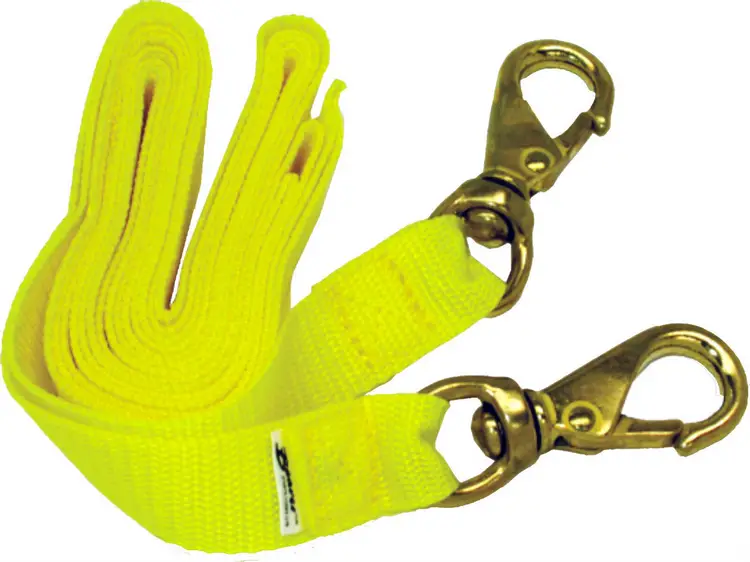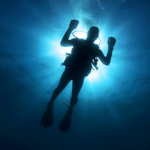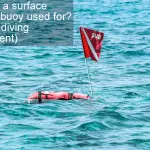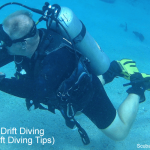
One of the most important rules of scuba diving is diving in buddy pairs. But one of the difficulties of diving as a buddy pair is when you’re diving in low visibility, or more importantly in a current during a drift dive in poor visibility.
When diving in low visibility, and especially if you’re diving in a current, there’s a bigger risk of getting split apart from your dive buddy. This is why it’s important to know what is a buddy line and if it’s a good idea.
A buddy line in scuba diving is a strap that physically tethers two scuba divers together underwater to avoid separation in low visibility conditions. A buddy line is even more important and is used more often on low visibility drift dives, as there’s more risk of being split apart in a current.
Pro Diver Tip: On a drift dive, one of you should be using a surface marker buoy (SMB) to indicate your position to the boat skipper. The other diver should be carrying a delayed surface marker buoy (DSMB) as safety equipment, which can be deployed in the case of being separated. If the diver who is not holding the SMB doesn’t have a DSMB it will be more difficult for the boat skipper to find them when they surface, which is especially the case in large swells.
The best way to do more diving is to book yourself on a scuba diving liveaboard. You can check the latest and best deals on liveaboards using the following window:
Is a buddy line a good idea?
A buddy line is a good idea in the following situations:
- When the visibility is less than 1-2 metres (3-7 feet), which is the type of visibility that makes it easy to lose your dive buddy. Whilst it’s not too much of a problem if you get split up as dive buddies (if you’re not a novice diver, see below), it does mean the end of your dive, as it’s recommended to surface if you are separated from your dive buddy.
- When the visibility is less than 2-3 metres (7-10 feet) and you’re diving in a current. If you are diving in a fast drift dive, and in low visibility, it doesn’t take much to get separated from your dive buddy. One diver only needs to stop for a matter of seconds when the visibility is less than 2-3 metres and their buddy will be out of sight very quickly.
- A buddy line is a very good idea when teaching low visibility diving to beginner divers. The last thing an instructor wants is to loose sight of their dive student in low visibility. The same is true when teaching novice divers their first drift dive. This is when a buddy line will make sure you are not separated from the novice diver. The last thing you want is for a beginner to need to surface on their own.
Pro Divers Tip: If you are diving on a drift dive in low visibility, and you don’t have a buddy line but you get separated, you may well find your buddy quite quickly, as you’ll be drifting in the same direction. However, only spend a few moments looking for your buddy before you abort the dive and come to the surface.
How long is a buddy line?
A buddy line tends to be between 2-3 metres (6-10 feet) long, and is often made with 25mm webbing and has snap hooks at either end for attaching to each diver.
As the two scuba divers are clipped together, if they move apart the line will tighten and this prevents them from separating. The buddy line can also be used to communicate buy giving the line a tug. The other diver will feel the tug and swim towards their buddy.
Alternatives to using a buddy line
If you don’t have a buddy line and you find yourself in poor visibility or in an unexpected current these are alternative solutions:
- Hold hands with your dive buddy. You may feel uncomfortable holding hands with your buddy, but it’s better to hold hands than loose each other and end up with a more serious problem.
- Hold the tank or BCD of your buddy. The alternative if you or your buddy are not the ‘hand-holding-type‘ is for one of you to hold your buddy’s dive tank or a part of their buoyancy control device.
- Use the SMB line as a buddy line. Another option is to both hold the SMB line if you are on a drift dive.
- Use the DSMB line. If at least one diver has a DSMB and no one has a buddy line, use the line from the DSMB reel instead.
- Keep in close range of your dive buddy. When diving in poor visibility and you don’t have a buddy line, and if you don’t want to hold onto each other, you should make sure to keep a good eye on your buddy at all times and stay in close visible range.

Safety precautions with using a buddy line diving
When you are tethered to another diver with a buddy line, you should be aware of underwater obstacles like wrecks, reefs or rocks. You therefore need to make sure you don’t get tangled or caught up in any entanglement hazard.
Entanglement hazards are more of a problem in drift dives, as you can sometimes be moving through the water quite fast. What could happen is the buddy line can get caught on a part of a wreck or a reef that can come upon you very quickly in a current.
Also, and just in case of an entanglement, make sure you are able to unclip the buddy line immediately. The alternative to being clipped to a buddy line using snap hooks is to hold the line in your hand.
Alternatively, you could use a line of cord or rope with a loop on each end, or a Velcro strap, and put this over each diver’s wrist. But make sure the loop is easily removed in an emergency.
Final thoughts on using buddy lines when scuba diving
Another tip is to use a floating device attached the the buddy line in the middle. A floating device will make sure the line remains out of the way. The theory is that a line floating above you, or certainly off the bottom, is less likely to get entangled and therefore makes it safer to use.
Finally, you can also use a buddy line as a Jon-Line. A Jon-line is used for a ‘hands-free‘ attachment at a deco-stop on a decompression dive.
I hope you enjoyed this page about what is a buddy line
If you have more questions either about snorkelling or scuba diving (or specifically about what is a buddy line), please comment below with your questions.
Please share your experiences, plus dive sites, resorts and liveaboards you recommend. Share the time of year of your trip together with what you saw, the visibility, currents and dive operator, as this will help others who read this page.
There will also be many more pages and articles about scuba and scuba diving safety tips (and on snorkelling too) for you to read and learn about this fabulous sport.
Have fun and be safe!




